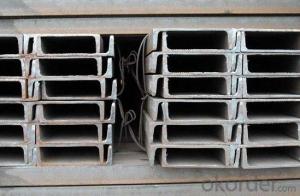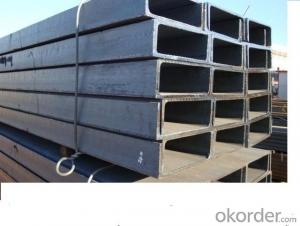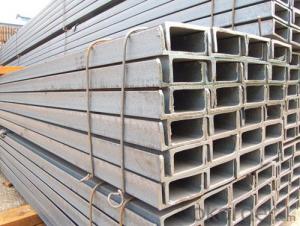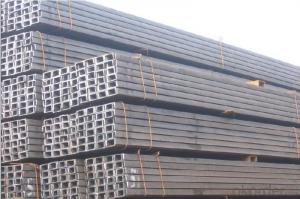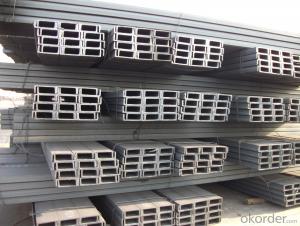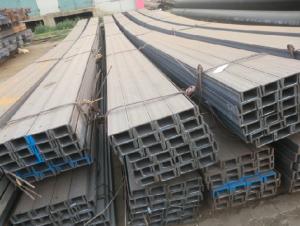GB Standard Steel Channel 200mm with High Quality
- Loading Port:
- China Main Port
- Payment Terms:
- TT or LC
- Min Order Qty:
- 25 m.t
- Supply Capability:
- 10000 m.t/month
OKorder Service Pledge
OKorder Financial Service
You Might Also Like
Product Description:
Specifications of GB Standard Steel Channel 200mm with High Quality:
1. We are definitely specializing in manufacturing and supplying channel steel.
| Standard: | GB/T 6723-86 |
| Sizes: | 200mm |
| Sales Volume/Year: | 10000MT |
| Destination Area: | Middle East, Africa, Southeast Asia |
2.Size, Length and Mass.
| Size(mm) | Length(m) | Mass(Kg/m) |
200*98*4 mm | 6m, 12m | 11.932 kg/m |
| 200*98*5 mm | 6m, 12m | 14.719 kg/m |
| 200*98*6 mm | 6m, 12m | 17.568 kg/m |
| 200*98*8 mm | 6m, 12m | 23.048 kg/m |
Package & Delivery of GB Standard Steel Channel 200mm with High Quality:
The steel u channel will be packed in bundle with steel wire at each end of every bundle and color marking in order to help the customer to recognize his goods more easily at sight.
And steel u channel could be loaded into 20ft or 40ft container, or by bulk cargo. If the weight of each bundle reaches less than 3.5 mt, the loading by break bulk cargo should be choosed. When the weight of each bundle reaches less than 3mt, the loading by container should be choosed.
As for the transportaion from mill to loading port, the truck will be usually used. And the maximum quantity for each truck is 40mt.
All in all, we could do in accordance with customer's request.
FAQ:
Q1: How soon can we receive the product after purchasement?
A1: Within three days of placing an order, we will begin production. The specific shipping date is dependent upon international and government factors, but is typically one month.
Q2: How do you guarantee the quality of our products?
A2: We have established an advanced quality management system which conducts strict quality tests at every step, from raw materials to the final product. At the same time, we provide extensive follow-up service assurances as required.
Q3: The prices are invoicing on theoritical weight or on actual weight?
A3: We can do it in both manners, according to the customers' request.
Images of GB Standard Steel Channel 200mm with High Quality:
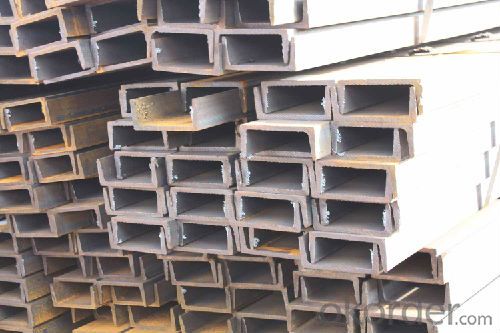
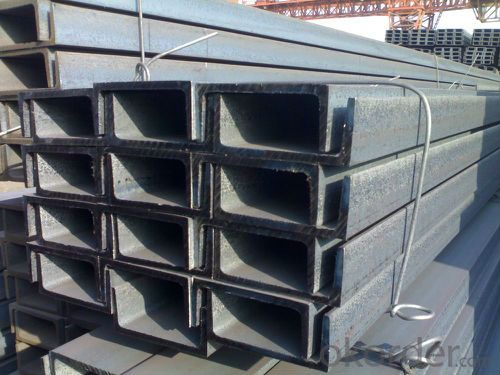
If you would like to get our price, please kindly inform us the standard/material, size and quantity. Thank you very much.
- Q: Are steel channels suitable for historical restoration projects?
- Depending on the project's requirements and objectives, steel channels may indeed be appropriate for historical restoration projects. They possess various advantages that contribute to their popularity in such endeavors. To begin with, steel channels are renowned for their strength and durability. When the original materials of historical buildings have weakened or deteriorated, they can provide structural support and stability. By reinforcing weakened walls, floors, or ceilings, steel channels guarantee the safety and longevity of the restored structure. Furthermore, steel channels can be tailored to mimic the original design and aesthetics of the historical building. They can be shaped and fabricated to replicate decorative moldings or ornamental elements, seamlessly integrating the modern material with the historical structure while preserving its authenticity. In addition, steel channels offer versatility in terms of size and shape, making them suitable for a wide array of restoration projects. They can replace or repair damaged structural elements like beams or columns. Moreover, steel channels can be utilized to create new additions or extensions to historical buildings, maintaining a harmonious balance between the old and the new. Nonetheless, it is crucial to consider the specific guidelines and regulations established by historical preservation organizations or authorities when employing steel channels in restoration projects. These guidelines may stipulate the use of specific materials or techniques to ensure the preservation of historical authenticity. Consequently, consulting with experts in historical restoration and obtaining necessary approvals before incorporating steel channels into a project is essential. To conclude, steel channels possess the qualities of durability, flexibility, and the ability to replicate original designs, making them a fitting choice for historical restoration projects. However, it is vital to give proper consideration to historical preservation guidelines in order to uphold the integrity and authenticity of the restored structure.
- Q: How do steel channels contribute to the overall functionality of a structure?
- Steel channels contribute to the overall functionality of a structure in several ways. Firstly, they provide structural support and stability, distributing the load evenly throughout the structure. Secondly, they help to reinforce the structure, increasing its strength and durability. Additionally, steel channels can be used for framing and creating openings in walls, floors, and ceilings, allowing for the integration of utilities such as electrical wiring and plumbing. Overall, steel channels play a crucial role in enhancing the structural integrity and functionality of a building.
- Q: How do steel channels perform under heavy loads?
- Steel channels are known for their exceptional strength and durability, making them highly capable of performing under heavy loads. The structural design of steel channels allows them to distribute and transfer the weight of heavy loads evenly, preventing any concentrated stress points that could cause failure. Additionally, steel channels have a high load-bearing capacity due to their ability to resist bending and twisting forces. This makes them ideal for supporting heavy machinery, equipment, or structures, ensuring stability and safety. Moreover, steel channels can withstand substantial compression and tension forces, making them suitable for a wide range of applications in various industries. Overall, steel channels excel in handling heavy loads by providing reliable support, stability, and load-bearing capabilities.
- Q: What are the different methods for connecting steel channels?
- There are several methods for connecting steel channels, each with its own advantages and applications. Some of the commonly used methods include: 1. Welding: Welding is one of the most common methods for connecting steel channels. It involves melting the two adjoining surfaces and joining them together using a similar or compatible metal filler material. Welding provides a strong and permanent connection, making it suitable for structural applications. 2. Bolting: Bolting involves using bolts, nuts, and washers to connect steel channels. This method is relatively easier and quicker compared to welding. Bolting provides a flexible connection, allowing for disassembly and reassembly if needed. It is commonly used in applications where frequent maintenance or adjustments are required. 3. Riveting: Riveting is a method of connecting steel channels using rivets, which are cylindrical metal pins. The rivets are inserted through pre-drilled holes in the channels and then hammered or compressed to secure them in place. Riveting provides a sturdy and reliable connection and is often used in heavy-duty applications. 4. Adhesive bonding: Adhesive bonding involves using specialized adhesives to join steel channels. This method provides a strong bond and is particularly useful in applications where welding or bolting may be impractical or undesirable. Adhesive bonding can also help distribute loads evenly across the joint, reducing stress concentrations. 5. Mechanical connectors: Mechanical connectors, such as beam clamps or connectors with threaded rods, are used to connect steel channels in applications where the channels need to be adjustable or reconfigurable. These connectors allow for easy installation and provide a secure connection without the need for welding or drilling. It is important to select the appropriate method for connecting steel channels based on factors such as the load-bearing requirements, structural integrity, ease of installation, disassembly, and future maintenance considerations. Consulting with a structural engineer or following established codes and standards can help ensure the appropriate method is chosen for a specific application.
- Q: Can steel channels be used in the construction of retaining walls?
- Absolutely, retaining walls can incorporate steel channels. These durable and strong structural components are commonly utilized in a range of construction endeavors. When integrated into retaining walls, they offer enhanced reinforcement and stability. Whether employed as vertical or horizontal supports, steel channels effectively distribute the load and thwart soil erosion. Moreover, their resistance to weathering and corrosion makes them an ideal long-term choice for retaining walls. Nonetheless, it is crucial to factor in the project's unique design prerequisites and seek guidance from a structural engineer to guarantee the accurate size, spacing, and positioning of the steel channels.
- Q: How do steel channels contribute to the durability of a structure?
- Steel channels contribute to the durability of a structure in several ways. Firstly, steel channels are made from a high-strength material which provides excellent resistance to external forces. This means that they can withstand heavy loads, impacts, and vibrations without deforming or breaking, ensuring the structural integrity of the building. Secondly, steel channels are designed with specific shapes and dimensions, allowing them to distribute the loads evenly across the structure. This helps in preventing localized stress concentrations, reducing the risk of fatigue failure over time. By evenly distributing the forces, steel channels can also minimize the potential for cracks or structural deformations, enhancing the long-term durability of the structure. Furthermore, steel channels offer superior corrosion resistance compared to other materials like wood or concrete. Steel is often protected with coatings or galvanized to prevent rust and corrosion, which can significantly extend the lifespan of the structure. This resistance to corrosion is particularly important in environments with high humidity, exposure to saltwater, or industrial pollutants. Another advantage of steel channels is their versatility and adaptability in construction. They can be easily fabricated and customized to fit the specific needs of a structure, including size, shape, and connection details. This flexibility allows for efficient construction and the ability to modify or expand the structure in the future without compromising its overall durability. Lastly, steel channels offer fire resistance, which is crucial for the safety and durability of a structure. Steel has a high melting point and does not contribute to the spread of fire, providing valuable time for occupants to evacuate and minimizing damage to the building. This fire resistance also reduces the need for extensive fireproofing measures, making steel channels a cost-effective solution for enhancing the durability of a structure. In summary, steel channels contribute to the durability of a structure by providing high-strength, even load distribution, corrosion resistance, versatility, and fire resistance. These qualities help ensure the longevity and safety of the building, making steel channels a valuable component in construction.
- Q: What are the different methods of reinforcing steel channels?
- There exist several techniques employed in enhancing the strength of steel channels, contingent upon the particular requirements and design factors involved. Some of the prevalent techniques encompass: 1. Welding: The most conventional and widely utilized method for reinforcing steel channels is welding. This process entails the fusion of supplementary steel plates or angles to the channel using heat and pressure. This technique ensures exceptional robustness and durability, enabling the reinforced channel to withstand substantial loads and stresses. 2. Bolting: Bolting is yet another frequently employed technique in reinforcing steel channels. It involves fastening additional steel plates or angles to the channel using bolts and nuts. This method is relatively swift and straightforward, permitting flexibility in making adjustments or modifications if necessary. 3. Riveting: Riveting is a method akin to bolting, except it employs rivets to secure the supplementary steel plates or angles to the channel. Riveting guarantees a firm and enduring connection, ensuring the reinforcement remains intact under diverse loading conditions. 4. Adhesive bonding: Adhesive bonding represents a contemporary approach that employs high-strength adhesives to affix additional steel plates or angles to the channel. This technique offers several advantages, including uniform distribution of loads, minimized stress concentrations, and improved aesthetics by eliminating the need for visible fasteners. 5. Fiber-reinforced polymers (FRP): FRP materials, such as carbon fiber or fiberglass, can be utilized to fortify steel channels. These materials possess lightweight properties, corrosion resistance, and high tensile strength. FRP can either be bonded or wrapped around the channel, providing supplementary reinforcement and enhancing its load-carrying capacity. 6. Composite construction: Composite construction involves the amalgamation of diverse materials, like concrete and steel, to reinforce steel channels. This technique is frequently employed in construction projects necessitating channel support for heavy loads or resistance against external forces, such as earthquakes or wind. It is imperative to note that the selection of a reinforcement method depends on various factors, including structural requirements, budgetary limitations, and environmental considerations. Consulting a structural engineer or construction professional is vital in determining the most suitable technique for reinforcing steel channels in a specific application.
- Q: Can steel channels be used for column stiffeners?
- Indeed, column stiffeners can utilize steel channels. Within construction and engineering domains, steel channels are frequently employed to augment the robustness and steadiness of structural elements. When functioning as column stiffeners, steel channels are commonly mounted vertically onto the column, heightening its ability to bear loads and withstand sideways pressures. Such stiffeners play a pivotal role in averting column buckling and distortion, thereby guaranteeing its structural integrity. The preference for steel channels as column stiffeners arises from their exceptional strength-to-weight ratio, durability, and effortless installation process.
- Q: What kind of steel products are there, such as channel steel, angle iron and so on?
- Round steelAs the name suggests, round steel is round section of circular solid steel, divided into hot rolling, forging and cold drawn three. Round steel has many materials, such as: 10#, 20#, 45#, Q215-235, 42CrMo, 40CrNiMo, GCr15, 3Cr2W8V, 20CrMnTi, 5CrMnMo, 304, 316, 20Cr, 40Cr, 20CrMo, 35CrMo and so on.Hot rolled round steel specifications 5.5-250 mm, small round steel is 5.5-25 mm, straight bundles of supply, as steel, bolts and various mechanical parts; greater than 25 mm round steel, mainly used in the manufacture of mechanical parts or seamless steel tube blank.
- Q: What kind of low carbon steel or medium carbon steel are they?
- Low carbon steel is not treated by heat before use. The carbon content is above 0.15%. It is treated by carburizing or cyaniding. It is used for shaft, shaft sleeve, chain wheel and other parts which require high surface temperature and good wear resistance. Low carbon steel is limited in use due to its low strength.Low carbon steel is generally rolled into angle steel, channel steel, I-beam, steel pipe, steel belt or steel plate. It is used to make all kinds of building components, containers, boxes, furnaces and agricultural machinery and so on.
Send your message to us
GB Standard Steel Channel 200mm with High Quality
- Loading Port:
- China Main Port
- Payment Terms:
- TT or LC
- Min Order Qty:
- 25 m.t
- Supply Capability:
- 10000 m.t/month
OKorder Service Pledge
OKorder Financial Service
Similar products
Hot products
Hot Searches
Related keywords
